Method Article
Osmometer Nanoliter הרומן LabVIEW המופעל לחקירות חלבון מחייב קרח
In This Article
Summary
חלבוני קרח מחייבים (IBPs), הידוע גם כחלבוני רדיאטור, לעכב צמיחה וקרח הם תוסף מבטיח לשימוש בהקפאה קריוגנית של רקמות. הכלי העיקרי המשמש לבדיקת IBPs הוא osmometer nanoliter. פתחנו שלב בית מעוצב קירור רכוב על מיקרוסקופ אופטי ונשלטתי באמצעות שגרת LabVIEW שהותקן. Osmometer nanoliter מתואר כאן מניפולצית טמפרטורת המדגם באופן אולטרה רגיש.
Abstract
Ice-binding proteins (IBPs), including antifreeze proteins, ice structuring proteins, thermal hysteresis proteins, and ice recrystallization inhibition proteins, are found in cold-adapted organisms and protect them from freeze injuries by interacting with ice crystals. IBPs are found in a variety of organism, including fish1, plants2, 3, arthropods4, 5, fungi6, and bacteria7. IBPs adsorb to the surfaces of ice crystals and prevent water molecules from joining the ice lattice at the IBP adsorption location. Ice that grows on the crystal surface between the adsorbed IBPs develops a high curvature that lowers the temperature at which the ice crystals grow, a phenomenon referred to as the Gibbs-Thomson effect. This depression creates a gap (thermal hysteresis, TH) between the melting point and the nonequilibrium freezing point, within which ice growth is arrested8-10, see Figure 1. One of the main tools used in IBP research is the nanoliter osmometer, which facilitates measurements of the TH activities of IBP solutions. Nanoliter osmometers, such as the Clifton instrument (Clifton Technical Physics, Hartford, NY,) and Otago instrument (Otago Osmometers, Dunedin, New Zealand), were designed to measure the osmolarity of a solution by measuring the melting point depression of droplets with nanoliter volumes. These devices were used to measure the osmolarities of biological samples, such as tears11, and were found to be useful in IBP research. Manual control over these nanoliter osmometers limited the experimental possibilities. Temperature rate changes could not be controlled reliably, the temperature range of the Clifton instrument was limited to 4,000 mOsmol (about -7.5 °C), and temperature recordings as a function of time were not an available option for these instruments.
We designed a custom-made computer-controlled nanoliter osmometer system using a LabVIEW platform (National Instruments). The cold stage, described previously9, 10, contains a metal block through which water circulates, thereby functioning as a heat sink, see Figure 2. Attached to this block are thermoelectric coolers that may be driven using a commercial temperature controller that can be controlled via LabVIEW modules, see Figure 3. Further details are provided below. The major advantage of this system is its sensitive temperature control, see Figure 4. Automated temperature control permits the coordination of a fixed temperature ramp with a video microscopy output containing additional experimental details.
To study the time dependence of the TH activity, we tested a 58 kDa hyperactive IBP from the Antarctic bacterium Marinomonas primoryensis (MpIBP)12. This protein was tagged with enhanced green fluorescence proteins (eGFP) in a construct developed by Peter Davies' group (Queens University)10. We showed that the temperature change profile affected the TH activity. Excellent control over the temperature profile in these experiments significantly improved the TH measurements. The nanoliter osmometer additionally allowed us to test the recrystallization inhibition of IBPs5, 13. In general, recrystallization is a phenomenon in which large crystals grow larger at the expense of small crystals. IBPs efficiently inhibit recrystallization, even at low concentrations14, 15. We used our LabVIEW-controlled osmometer to quantitatively follow the recrystallization of ice and to enforce a constant ice fraction using simultaneous real-time video analysis of the images and temperature feedback from the sample chamber13. The real-time calculations offer additional control options during an experimental procedure. A stage for an inverted microscope was developed to accommodate temperature-controlled microfluidic devices, which will be described elsewhere16.
The Cold Stage System
The cold stage assembly (Figure 2) consists of a set of thermoelectric coolers that cool a copper plate. Heat is removed from the stage by flowing cold water through a closed compartment under the thermoelectric coolers. A 4 mm diameter hole in the middle of the copper plate serves as a viewing window. A 1 mm diameter in-plane hole was drilled to fit the thermistor. A custom-made copper disc (7 mm in diameter) with several holes (500 μm in diameter) was placed on the copper plate and aligned with the viewing window. Air was pumped at a flow rate of 35 ml/sec and dried using Drierite (W.A. Hammond). The dry air was used to ensure a dry environment at the cooling stage. The stage was connected via a 9 pin connection outlet to a temperature controller (Model 3040 or 3150, Newport Corporation, Irvine, California, US). The temperature controller was connected via a cable to a computer GPIB-PCI card (National instruments, Austin, Texas, USA).
Protocol
0. הליכים המקדמיים
- זכוכית נימים להזרקת תמיסה. שימוש חולץ נימים (Narishige, טוקיו, יפן), להכין פיפטה חדה עם פתיחה מצוינת משפופרת מייקר נימי זכוכית (המותג GMBH, ורטהיים, גרמניה). גודל הפתח צריך להיות מאומת על ידי העברת אוויר דרך הנימים להשיג מבעבע עדינה במים נקיים. אם הנימים סגורות, ניתן לפתוח אותו על ידי שבירת הקצה שלה. ניתן לעשות זאת על ידי לחיצה או מגרדים אותו בעדינות על צינור המים המכילים קירות. הכן כגון נימים שהפתח חסום כמעט אך מספיק פתוח על מנת לאפשר ההיווצרות של בועות תת מילימטר.
- ניקוי דיסק נחושת. Sonicate את דיסקי הנחושת למשך 10 דקות במייקרו 0.1%-90 סבון (קול-לבן זוג, ורנון הילס, אילינוי, ארה"ב), ואז לשטוף עם מים מזוקקים כפולים. להציג את הדיסקים לפתרון isopropanol (טכני) וsonicate שוב למשך 10 דקות. סנפירברית, לייבש את הדיסקים באמצעות אוויר מסונן. שלב ניקוי זו הוא קריטי כדי למנוע זיהום IBP בין ניסויים.
- הרכבת coverglass כפולת שכבה. הרכבת coverglass הייתה מוכנה לאפשר לתצפית מדגם ללא עיבוי לחות על פני שטח כיסוי הזכוכית. זו הושגה על ידי צבת Drierite חלקיקים (WA המונד Drierite, קסניה, אוהיו, ארה"ב) (2 מ"מ קוטר) בין שתי coverslips, שלאחר מכן הדביק עם אקדח דבק חם. תצורה זו מונעת עיבוי שעלולה לחסום את הנוף כאשר הדגימה קוררה לטמפרטורות נמוכות ובטלה את הצורך לפוצץ באוויר יבש לחלון התצפית.
1. שלב הקירור Set-up
- חבור את כניסת מי זרימה והיציאה של שלב הקירור עד 4 מ"מ קוטר פנימיים Tygon צינורות (Saint-Gobain, פריז, צרפת), ולחבר את צינור יניקת זרימת מים למשאבת מים.
- חבר צינור 4 Tygon קוטר פנימי מ"מ ליניקה של t שלב הקירורo לספק אוויר יבש. האוויר היה יבש באמצעות עמודת Drierite באונליין.
- להפעיל את משאבות אוויר ומים. שים לב כי יסודות הקירור לא צריכים לרוץ בלי גוף קירור.
- הפעל את בקר הטמפרטורה, מצלמה, ושגרת LabVIEW.
2. לדוגמא הכנה
- הנח טיפת μl 3-4 טבילת השמן B (Cargille מעבדות, סדר גרוב, ניו ג'רזי, ארה"ב) בצד האחורי של דיסק נחושת קוטר 7 מ"מ היו 500 מיקרומטר חורים שנקדחו באמצעות הדיסק.
- מקם את דיסק הנחושת על הבמה עם קירור צד שמן הטבילה פונה כלפי מטה.
- לחבר את צינור הנימים (בקצה הקהה) לצינור בקוטר 0.7 מ"מ פנימי Tygon מחובר בקצה השני למזרק 2 מיליליטר זכוכית (Poulten-גרף, ורטהיים, גרמניה).
- לפני שימוש בצינור הנימים, בדוק את הפתח הקטן של הנימים כדי להבטיח שהפתיחה היא גודל מתאים (ראה הליכים המקדמיים).
- לאט לאט להכניס את GLAss נימים לתוך הצינור המוכן IBP חלבון המדגם (2.4 מיקרומטר Mp IBP-GFP ב20 מ"מ CaCl 2 ו 25 מ"מ טריס-HCl ב-pH 8, ראה התייחסות 10 לפרטי ההכנה) ומושך את מזרק הזכוכית עד נימי הזכוכית מכילה 0.1 μl של חלבון הפתרון.
- להתחיל בהקלטת וידאו באמצעות תוכנת LabVIEW.
- הכנס את הקצה החד של זכוכית הנימים (המכיל חלבון הפתרון) לאחד החורים בדיסק הנחושת בשלב הקירור.
- תוך כדי התבוננות מבעד למיקרוסקופ (אולימפוס, טוקיו, יפן, אובייקטיבי 10x), לחדור בזהירות את שכבת שמן הטבילה עם קצה נימי הזכוכית, ולחץ על מזרק הזכוכית (מאוד בעדינות) כדי לספק כמות קטנה (~ 10 NL) של החלבון פתרון כדי ליצור טיפת מיקרומטר 200.
- כסה את החור בשלב הקירור עם מכלול coverglass שכבה הכפולה (ראה הליכים המקדמיים).
3. מדידת פעילות TH
- קדםss כפתור הקירור ולקבוע את הטמפרטורה ל -40 ° C.
- בתחילה, אגל הפתרון יהיה ברור. בטמפרטורות נמוכות, בדרך כלל בטווח -30 ° C עד -35 ° C, צבע שינויי האגל, מצביע על כך שהפתרון הוקפא. מייד לאחר המדגם הקפיא, להגדיל את הטמפרטורה לאט לאט עד שהקרח בתפזורת מתחיל להתמוסס. עלייה הדרגתית של הטמפרטורה נחוצה כדי למנוע להחטיא מהטמפרטורה שעלולה לגרום להמסה המלאה של המדגם.
- מעבר למטרת 50x ומתחיל להמס את הקרח על ידי התאמת הטמפרטורה. התאמה זו היא אינטראקטיבית, והשלבים הסופיים בדרך כלל מבוצעים באמצעות צעדי טמפרטורה קטנות של 0.002 מעלות צלזיוס תמשיך לינמס עד גביש יחיד נשאר. הגודל הסופי של הגביש צריך להיות בסביבות 10 מיקרומטר. הטמפרטורה הגבוהה ביותר שבי ההיתוך חדל תיקבע כנקודת התכה ונקבעה במדויק בשלב ניתוח וידאו מאוחר יותר.
- הגדר את הטמפרטורה לכמה מאיות צלזיוס תואר מתחת לנקודת ההתכה של הגביש ולהתחיל רמפת טמפרטורה באיחור 10 דקות. להתאים את קצב ramping כרצונך. במהלך תקופה זו, הגביש יהיה חשוף לIBPs.
- עם סיום זמן החשיפה 10 דקות, הטמפרטורה פחתה באופן אוטומטי תחת השליטה של שגרת LabVIEW.
- שים לב לצורת גביש כירידות בטמפרטורה. בשלב מסוים, הפרץ הפתאומי של גביש הקרח יכול להיות שנצפה. הטמפרטורה שבה זה מתרחש תצוין כטמפרטורת פרץ הגביש.
- השתמש בניתוח וידאו על מנת לקבוע את נקודת ההתכה המדויקת וטמפרטורת הפרץ. ראשית, על ידי שימוש בניתוח וידאו, למצוא את נקודת ההתכה המדויקת. תזכיר כי הטמפרטורה הגבוהה ביותר שבי ההיתוך חדל תיקבע כנקודת התכה. לתעד את נקודת התכה זה בתוכנת גיליונות אלקטרוניים. לאחר מכן, לקבוע את טמפרטורת פרץ הגביש המדויקת, ולתעד את הערך הזהגם כן. ההבדל בין נקודת ההיתוך ונקודת קיפאון, או בטמפרטורת פרץ גביש, הוא פעילות hysteresis התרמית של פתרון IBP.
4. מדידה של פעילות TH תלוית זמן
- עקוב הפרוטוקול המתואר בסעיפים 3.1-3.3 להכין גביש יחיד של קרח.
- לאחר ההיווצרות של הגביש, להגדיר את זמן ההשהיה של הרמפה כרצון, ולהפעיל את הרמפה.
- הטמפרטורה תקטן בשיעור קבוע (בהתאם לדרישות של המפעילים) באופן אוטומטי לאחר זמן השהית הרמפה עבר.
- לתעד את הטמפרטורה שבה פרץ הגביש מתרחש. לחשב את זמן החשיפה (הזמן בין היווצרות גבישים ופרץ הגביש).
- חזור על הניסוי לזמני השהיה שונים ולהתוות את פעילות TH כפונקציה של זמן החשיפה על מנת להעריך את זמן התלות של פעילות TH.
תוצאות
מדידה של תלות זמן TH
Osmometer nanoliter LabVIEW המופעל מאפשר ביצוע מדידות פעילות TH מדויקות. שיעור הפחתת הטמפרטורה הקבועה מותר המדידה של תלות זמן TH. בקרת הטמפרטורה המדויקת מופעלת על ידי osmometer nanoliter הייתה חיונית לניסויים אלה. זמן החשיפה של גביש קרח לIBPs בפתרון מוגדר כפרק זמן מהיווצרות הגבישים (סופו של תהליך ההיתוך) עד הצמיחה הפתאומית של קרח סביב הגביש (פרץ גביש). מצאנו כי זמן החשיפה של גבישי הקרח לIBPs מושפע פעילות TH מכריע. תקופות קצרות של חשיפת IBP (כמה שניות) המיוצרות על פעילות TH נמוכה בפתרון Mp IBP-GFP (2.4 מיקרומטר) (איור 5). פעילות TH גדלה עם זמן החשיפה IBP עד שהגיע לרמה של 4 חשיפת IBP דקות. בריכוזים גבוהים יותר IBP, הצלחתau, הושג בזמנים קצרים יותר.
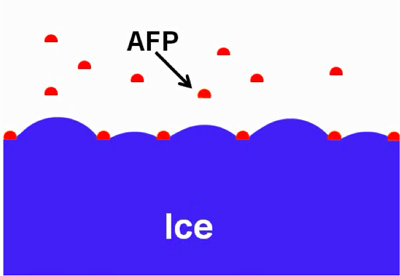
האיור 1. IBPs ממחיש תרשים סכמטי adsorbed לקרח. אמץ באישור 10.
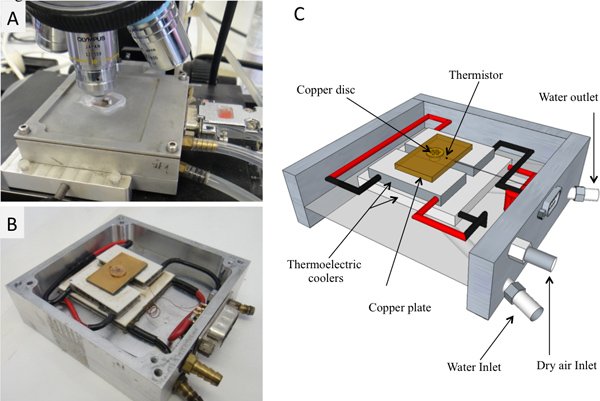
איור 2. שלב הקירור. ) מחובר לצינורות במיקרוסקופ. ב) בלי להוביל העליון. ג) תרשים סכמטי.
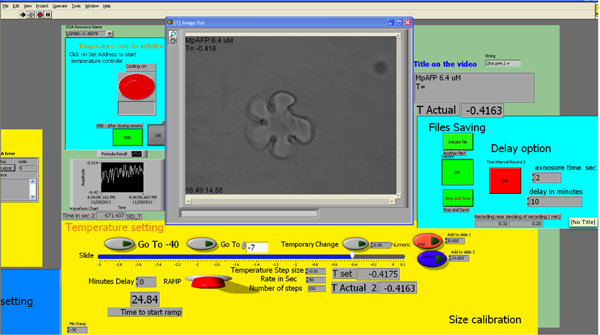
איור 3. תמונת מסך של ממשק LabVIEW. Clאיכס כאן לצפייה בדמות גדולה.
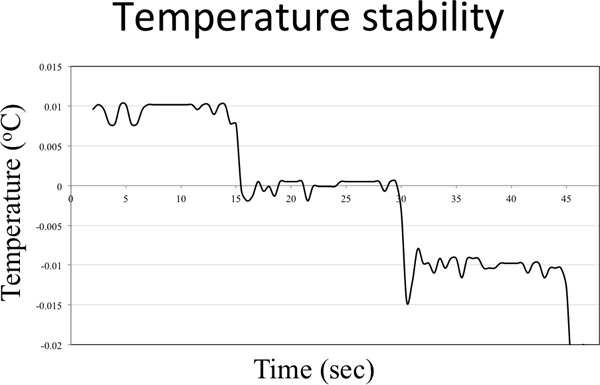
איור 4. גרף יציבות טמפרטורה. בקר הטמפרטורה נקבע שתוריד את טמפרטורת 0.01 ° C בכל 15 שניות.
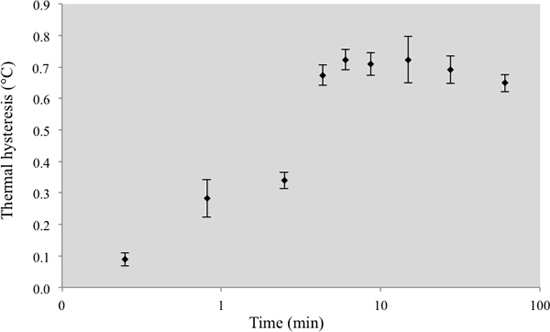
איור 5. פעילות TH Mp IBP כפונקציה של זמן חשיפת גביש קרח לIBPs. כל נקודת זמן היא ממוצעת של 3-6 ניסויים.
Discussion
עבודה זו ממחישה את הפעולה של osmometer nanoliter מבוקר מחשב המאפשר מדידות מדויקות של פעילות TH עם בקרת טמפרטורה יוצאת דופן. בכל מערכת רגישה לטמפרטורה, גרדיאנטים בטמפרטורה רצוי יש להימנע. כדי להימנע משיפועי טמפרטורה במנגנון שהוצג כאן, אגל פתרון המבחן חייב להיות ממוקם במרכז חור בשלב קירור דיסק הנחושת (שלב 2.7). בנוסף, הגביש היחיד צריך להיות במרכז של רביב ולא ליד הקצוות (ברוב המקרים, זה לא יקרה באופן ספונטני). תלות הזמן המתואר מצביעה על כך שקצב הקירור עשוי להשפיע על קריאות ה. לפיכך, אנו ממליצים לרבות דוח של הזמן שבו הגביש נחשף לפתרון לפני הקירור, כמו גם את קצב הקירור. אנחנו בדרך כלל חיכינו 10 דקות לפני ramping את הטמפרטורה ב0.01 ° C שלבים כל 4 שניות.
את שיתוף LabVIEW המבוקרשלב oling הותאם לשימוש עם מיקרוסקופ ההפוך שבו יכולים להיות שהופעלו התקני microfluidic תרמית. מערכת זו מאפשרת ביצוע הניסויים בexchange פתרון של גבישי קרח וIBPs מתויגים עם 9 eGFP, 10, 16. מערכת LabVIEW המבוקרת עשויה להיות מותאמת לשלב קליפטון על ידי חיבור בקר 3040 טמפרטורה באמצעות מעגל חשמלי ייעודי הסתגלות. מערכת כזו פעלה בדייויס 17 המעבדה. תוכנת LabVIEW והעיצוב הייעודי התאמת המעגל החשמלי לבמת קליפטון זמין לפי בקשה.
לסיכום, אנו מתארים osmometer nanoliter המאפשר שליטה הרגישה ומניפולציה של טמפרטורה וקצב עליית הטמפרטורה והירידה (עם רגישות 0.002 ° C), בתיאום עם ממשק וידאו דרך שגרת LabVIEW לניתוח בזמן אמת. מערכת זו יכולה לבצע ניסויים לשעתק שיעור בשליטה כי הם importanלא לחקירת קינטיקה של אינטראקציות IBP עם קרח. ניסויים כאלה יכולים לטפל בכמה בעיות ארוכות התווכחו מקיפות את מנגנון פעולה של IBPs.
Disclosures
אין ניגודי האינטרסים הכריזו.
Acknowledgements
מחקר זה נתמך על ידי הקרן הלאומי למדע, NSF, וERC. ברצוננו להודות לעזרה טכנית שלב הטמפרטורה מרנדי מילפורד, מייקל קורן, דאג שייפר, וג'רמי דניסון. סיוע בפיתוח תוכנה סופק על ידי אור חן, די שו, Rajesh Sannareddy, וSumit Bhattachary. ברצוננו להודות לעמיתי פרופ 'פיטר ל' דייויס וד"ר לורי א גרהם לחלבון Mp IBP ודיונים מועילים. אנו מודים גם לחברי מעבדת ד"ר מאיה הבר דולב, Yangzhong צ'ין, ד"ר Yeliz סליק, ד"ר נטליה Pertaya, אורטל Mizrahy, וגיא שלומית למשוב מהמשתמשים שלהם.
Materials
| Name | Company | Catalog Number | Comments |
| שם | חברה | מספר קטלוגים / דגם | תגובות |
| טבילת שמן מהסוג B | מעבדות Cargille | 16484 | |
| Drierite | WA המונד Drierite | 043063 2270g | |
| תמיסת ניקוי מייקרו 90 | קולמן לבן זוג | EW-18100-11 | |
| נימי חולץ | Narishige | PB-7 | |
| צינורות זכוכית נימים | המותג GNBH | 7493 21 | 75 מ"מ אורך, 1.15 קוטר |
| טמפרטורהבקר | ניופורט, אירווין, קליפורניה, ארצות הברית | דגם 3040 | דגם 3040 |
| מיקרוסקופ אור | אולימפוס | דגם BH2 | |
| מטרת 10x | אולימפוס | S תכנית 10, 0.3, 160/0.17 | |
| מטרת 50x | ניקון | CF תכנית, 50X/0.55 EPI ELWD | |
| CCD מצלמה | Provideo | CVC-140 | |
| צינורות Tygon | Saint-Gobain, פריז, צרפת | Tygon הגיבוש Tubing S-50-HL | |
| זכוכית המזרק (2 מ"ל) | Poulten-גרף, ורטהיים, גרמניה | 7 10227 | |
| כרטיס PCI-GPIB | המכשירים לאומיים, אוסטין, טקסס, ארה"ב | 778032-01 | |
| וידאו המסגרת grabber IMAQ-PCI-1407 | המכשירים לאומיים, אוסטין, טקסס, ארה"ב | 322156B-01 | |
| תוכנת עיצוב מערכת LabVIEW | המכשירים לאומיים, אוסטין, טקסס, ארה"ב | גרסה 8 | |
| תוכנת מחבר DIVX | DivX LLC, סן דייגו, קליפורניה, ארה"ב |
References
- DeVries, A. L. Glycoproteins as biological antifreeze agents in antarctic fishes. Science. 172, 1152-1155 (1971).
- Worrall, D., Elias, L., Ashford, D., Smallwood, M., Sidebottom, C., Lillford, P., Telford, J., Holt, C., Bowles, D. A carrot leucine-rich-repeat protein that inhibits ice recrystallization. Science. 282, 115-117 (1998).
- Raymond, J. A., Knight, C. A. Ice binding, recrystallization inhibition, and cryoprotective properties of ice-active substances associated with Antarctic sea ice diatoms. Cryobiology. 46, 174-181 (2003).
- Tomchaney, A. P., Morris, J. P., Kang, S. H., Duman, J. G. Purification, composition, and physical properties of a thermal hysteresis "antifreeze" protein from larvae of the beetle, Tenebrio molitor. Biochemistry. 21, 716-721 (1982).
- Kiko, R. Acquisition of freeze protection in a sea-ice crustacean through horizontal gene transfer. Polar Biology. 33, 543-556 (2010).
- Robinson, C. H. Cold adaptation in Arctic and Antarctic fungi. New Phytol. 151, 341-353 (2001).
- Gilbert, J. A., Hill, P. J., Dodd, C. E., Laybourn-Parry, J. Demonstration of antifreeze protein activity in Antarctic lake bacteria. Microbiology. 150, 171-180 (2004).
- Raymond, J. A., DeVries, A. L. Adsorption inhibition as a mechanism of freezing resistance in polar fishes. Proc. Natl. Acad. Sci. U.S.A. 74, 2589-2593 (1977).
- Pertaya, N., Marshall, C. B., DiPrinzio, C. L., Wilen, L., Thomson, E. S., Wettlaufer, J. S., Davies, P. L., Braslavsky, I. Fluorescence microscopy evidence for quasi-permanent attachment of antifreeze proteins to ice surfaces. Biophys. J. 92, 3663-3673 (2007).
- Celik, Y., Graham, L. A., Mok, Y. F., Bar, M., Davies, P. L., Braslavsky, I. Superheating of ice crystals in antifreeze protein solutions. Proc. Natl. Acad. Sci. U.S.A. 107, 5423-5428 (2010).
- Gilbard, J. P., Farris, R. L., Santamaria, J. Osmolarity of tear microvolumes in keratoconjunctivitis sicca. Arch. Ophthalmol. 96, 677-681 (1978).
- Gilbert, J. A., Davies, P. L., Laybourn-Parry, J. A hyperactive, Ca2+-dependent antifreeze protein in an Antarctic bacterium. FEMS Microbiol. Lett. 245, 67-72 (2005).
- Soriano, J., Braslavsky, I., Xu, D., Krichevsky, O., Stavans, J. Universality of persistence exponents in two-dimensional ostwald ripening. Phys. Rev. Lett. 103, (2009).
- Tomczak, M. M., Marshall, C. B., Gilbert, J. A., Davies, P. L. A facile method for determining ice recrystallization inhibition by antifreeze proteins. Biochem. Bioph. Res. Co. 311, 1041-1046 (2003).
- Knight, C. A., Hallett, J., Devries, A. L. Solute Effects on Ice Recrystallization - an Assessment Technique. Cryobiology. 25, 55-60 (1988).
- Celik, Y., Drori, R., Pertaya-Braun, N., Altan, A., Barton, T., Bar-Dolev, M., Groisman, A., Davies, P. L., Braslavsky, I. Microfluidic experiments reveal that antifreeze proteins bound to ice crystals suffice to prevent their growth. Proc. Natl. Acad. Sci. U.S.A. 110, 1309-1314 (2013).
- Middleton, A. J., Marshall, C. B., Faucher, F., Bar-Dolev, M., Braslavsky, I., Campbell, R. L., Walker, V. K., Davies, P. L. Antifreeze protein from freeze-tolerant grass has a beta-roll fold with an irregularly structured ice-binding site. J. Mol. Biol. 416, 713-724 (2012).
Reprints and Permissions
Request permission to reuse the text or figures of this JoVE article
Request PermissionExplore More Articles
This article has been published
Video Coming Soon
Copyright © 2025 MyJoVE Corporation. All rights reserved